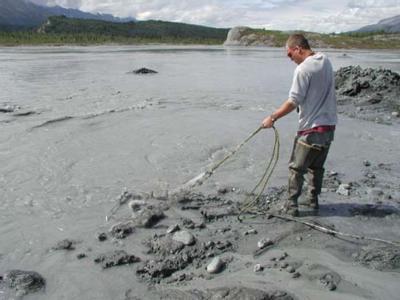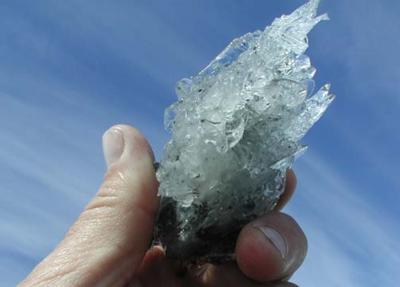18 July, 2000
July 18, 2000
Matanuska Glacier, Alaska
I finally got a good look at the moose and calf that have been seen in
this area recently. As I was coming back from uploading pictures on
Sunday night I luckily happened to notice them before getting too close.
Cashman and Josh accidentally got too close to them one morning before I
arrived and she charged at them to protect her calf. It was nearly 10:30
at night and with the thick clouds and the late hour it wasnít very
bright out. They almost blended into a pile of slender spruce logs that
had been stacked next to the gravel airstrip here. Both of them were
frozen in place and looking at me. I paused for a minute and then
decided to back up a bit before heading off down the side of the
airstrip, perhaps fifty yards from them. I kept watching as they
disappeared behind the pile. I eventually could see that the cow had
come to the other side of the wood pile to keep an eye on me. I
continued on my way back to camp. About a week ago I was entertained by
the warning barks of a fox in this same area, also late in the evening.
Perhaps some night I should stay up and go for a long hike!
The weather finally improved a bit today and got quite nice for awhile.
It was a nice break from the past week or so. Yesterday evening it felt
especially cool with a constant strong wind whirling through camp.With
the clouds and cooler temperatures of the past week you can really tell
the melting on the glacier has decreased significantly. All the vents
and rivulets are much slower than they had been.
Last night we discussed our project with Jeffrey Strasser and it was
decided to proceed aggressively with the dye tracing experiment. We will
wait until Thursday to try our first experiment so that we can take
advantage of the extra manpower that will be available when all the REU
students are here. At that time we will have four ISCO water samplers to
place in different vents, ones that we feel have the best chance of the
dye draining through. We want to try to establish the moulin/vent
connection quickly and sample as many as possible. Once thatís
accomplished then we wonít need but one or two at the vent or vents that
turn up with the dye.
Initially we will dump just one bottle of dye as it is thought from past
attempts to be sufficient. We will then dump more if necessary. We plan
to dump into the same moulin that we have with the salt in earlier
tests. We will also keep the current ISCOs at Trail Vent and Little
River Vent. The other two will be placed at two of the more active vents
in the Mammoth Vent area.
We went to this area of vents today with Cashman to look things over.
The flow from the vents has decreased significantly recently and we
needed to evaluate our placement. In spite of reduced flow there is
significant amounts of frazil ice forming from the supercooled vent
water. It appeared at first that one of the CTDís attached with the ISCO
tube had frozen in but Ben eventually got it to spring free. Every time
the devices are pulled from a vent they must be cleaned of this ice that
grows on the ropes and instruments to prevent their getting frozen in.
It reminds me of growing crystals in chemistry class at school as every
day the thread suspending the seed crystal needed to be cleaned of the
new crystals beginning to form along its length . Crystals can only form
onto existing surfaces and this frazil ice is no different, growing on
the instruments and extending from rocks and ice around the vents.
Eventually frazil ice may form ice terraces out from the surface of the
water much like mineral terraces form in Yellowstone. That hasnít
happened here yet, but Iím hoping to get to see that form some day.
Marvin Giesting

Ben Cashman pulling in the CTD and ISCO tube from one of the Mammoth Vents. They've been called this not due to the size of any one vent, but because there are numerous vents concentrated in a small area here.

Quite a bit of frazil ice can form on the instrument and ropes in just 48 hours in a vent.

A piece of frazil ice taken from the CTD. It appears to have flat, tongue-like crystals of ice sticking out.
Contact the TEA in the field at
.
If you cannot connect through your browser, copy the
TEA's e-mail address in the "To:" line of
your favorite e-mail package.
|
